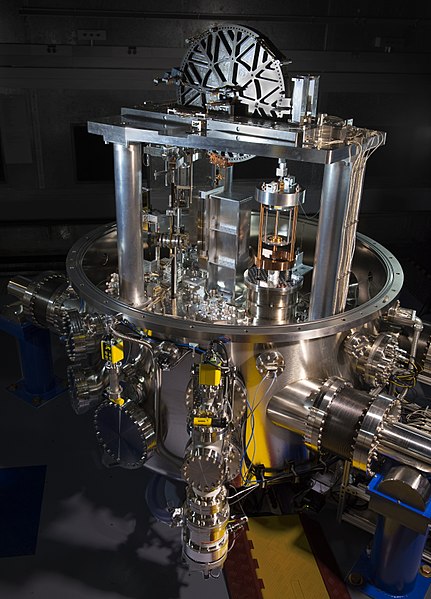International Prototype of the Kilogram
The International Prototype of the Kilogram is an object whose mass was used to define the kilogram from 1889, when it replaced the Kilogramme des Archives, until 2019, when it was replaced by a new definition of the kilogram based entirely on physical constants. During that time, the IPK and its duplicates were used to calibrate all other kilogram mass standards on Earth.
The International Prototype Kilogram, stored in a vault in Paris, was replaced in 2019 by a formula that uses the Planck constant, since the IPK’s mass is unstable over time.
National prototype kilogram K20, one of two prototypes stored at the US National Institute of Standards and Technology in Gaithersburg, Maryland, which serve as primary standards for defining all units of mass and weight in the United States. This is a replica for public display, shown as it is normally stored, under two bell jars.
Mass drift over time of national prototypes K21–K40, plus two of the IPK's sister copies: K32 and K8(41). All mass changes are relative to the IPK. The initial 1889 starting-value offsets relative to the IPK have been nulled. The above are all relative measurements; no historical mass-measurement data is available to determine which of the prototypes has been most stable relative to an invariant of nature. There is the distinct possibility that all the prototypes gained mass over 100 years and that K21, K35, K40, and the IPK simply
A replica of the prototype kilogram on display at Cité des Sciences et de l'Industrie in Paris, featuring the protective double glass bell.
Metrology is the scientific study of measurement. It establishes a common understanding of units, crucial in linking human activities. Modern metrology has its roots in the French Revolution's political motivation to standardise units in France when a length standard taken from a natural source was proposed. This led to the creation of the decimal-based metric system in 1795, establishing a set of standards for other types of measurements. Several other countries adopted the metric system between 1795 and 1875; to ensure conformity between the countries, the Bureau International des Poids et Mesures (BIPM) was established by the Metre Convention. This has evolved into the International System of Units (SI) as a result of a resolution at the 11th General Conference on Weights and Measures (CGPM) in 1960.

A Kibble balance, which is used to measure weight via electric current and voltage. With this instrument, the measurement of mass is no longer dependent on a defined mass standard and is instead dependent on natural physical constants.
Computer-generated image realising the international prototype of the kilogram (IPK), made from an alloy of 90-per cent platinum and 10-per cent iridium by weight






